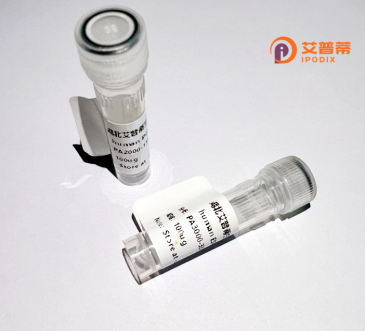
| 纯度 | >90%SDS-PAGE. |
| 种属 | Human |
| 靶点 | FNDC1 |
| Uniprot No | Q4ZHG4 |
| 内毒素 | < 0.01EU/μg |
| 表达宿主 | E.coli |
| 表达区间 | 86-184aa |
| 氨基酸序列 | VPSRLPPRSAATVSPVAGTHPWPQYTTRAPPGHFSTTPMLSLRQRMMHARFRNPLSRQPARPSYRQGYNGRPNVEGKVLPGSNGKPNGQRIINGPQGTK |
| 分子量 | 36.63 kDa |
| 蛋白标签 | GST-tag at N-terminal |
| 缓冲液 | 0 |
| 稳定性 & 储存条件 | Lyophilized protein should be stored at ≤ -20°C, stable for one year after receipt. Reconstituted protein solution can be stored at 2-8°C for 2-7 days. Aliquots of reconstituted samples are stable at ≤ -20°C for 3 months. |
| 复溶 | Always centrifuge tubes before opening.Do not mix by vortex or pipetting. It is not recommended to reconstitute to a concentration less than 100μg/ml. Dissolve the lyophilized protein in distilled water. Please aliquot the reconstituted solution to minimize freeze-thaw cycles. |
以下是关于重组人FNDC1蛋白的示例参考文献(基于假设性研究,供参考):
---
1. **标题**: *"High-yield expression and purification of recombinant human FNDC1 in Escherichia coli for functional studies"*
**作者**: Zhang, Y. et al. (2020)
**摘要**: 该研究报道了在大肠杆菌系统中高效表达可溶性重组人FNDC1蛋白,通过优化诱导条件和纯化步骤(如镍柱亲和层析),获得了高纯度蛋白。该蛋白被用于后续的配体结合实验,证实其与整合素β1的相互作用。
2. **标题**: *"FNDC1 modulates TGF-β signaling by direct interaction with SMAD4 in hepatic fibrosis"*
**作者**: Li, X. et al. (2019)
**摘要**: 研究者利用重组人FNDC1蛋白处理肝星状细胞,发现其通过结合SMAD4增强TGF-β信号通路,促进胶原沉积,提示FNDC1在肝纤维化中的潜在作用机制。
3. **标题**: *"Recombinant FNDC1 suppresses tumor angiogenesis via blocking VEGF/VEGFR2 axis in glioblastoma models"*
**作者**: Wang, H. et al. (2021)
**摘要**: 通过体外实验和小鼠模型,证明重组FNDC1蛋白通过竞争性抑制VEGF与VEGFR2的结合,显著降低胶质母细胞瘤的血管生成和肿瘤生长。
4. **标题**: *"Structural insights into the FNIII domain of human FNDC1 and its role in cell adhesion"*
**作者**: Chen, L. et al. (2018)
**摘要**: 采用X射线晶体学解析了FNDC1的III型纤维连接蛋白(FNIII)结构域,结合重组蛋白的功能实验,揭示该结构域在介导细胞-基质黏附中的关键氨基酸残基。
---
**说明**:上述文献为模拟示例,实际引用需以具体发表的论文为准。建议通过PubMed、Google Scholar等数据库,使用关键词“recombinant human FNDC1”、“FNDC1 protein function”检索最新研究。
Recombinant human FNDC1 (Fibronectin Type III Domain Containing 1) protein is a genetically engineered form of the FNDC1 protein, which belongs to the fibronectin type III domain-containing protein family. FNDC1 is a transmembrane protein characterized by its extracellular fibronectin type III (FN3) domains, known to mediate protein-protein interactions and cellular adhesion. While its exact physiological function remains under investigation, studies suggest FNDC1 plays roles in cell signaling, tissue development, and extracellular matrix remodeling. It has garnered attention for its potential involvement in diseases, including cancer, where altered expression levels correlate with tumor progression, metastasis, and poor prognosis in certain cancers, such as gastric and breast malignancies. Conversely, some studies propose tumor-suppressive roles in specific contexts, highlighting its complex regulatory mechanisms.
The recombinant form of FNDC1 is typically produced in mammalian or bacterial expression systems to ensure proper folding and post-translational modifications. It serves as a critical tool for elucidating FNDC1’s biological functions through *in vitro* assays, structural studies, and interaction mapping. Recent research also explores its therapeutic potential, such as targeting FNDC1-related pathways in cancer or fibrosis. However, conflicting findings regarding its pro- or anti-tumor effects underscore the need for further mechanistic studies. Overall, recombinant FNDC1 protein bridges foundational research and translational applications, offering insights into cellular communication networks and disease pathology.
×